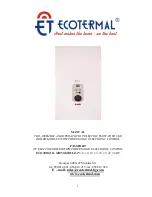
www.johnsonandstarley.co.uk
3
1. IMPORTANT INFORMATION
IT IS A STATUTORY REQUIREMENT THAT ALL GAS APPLIANCES ARE INSTALLED BY COMPETENT PERSONS, (i.e.
CORGI REGISTERED INSTALLERS) IN ACCORDANCE WITH THE GAS SAFETY (INSTALLATION AND USE) REGULA-
TIONS (CURRENT EDITION). FAILURE TO COMPLY WITH THESE REGULATIONS MAY LEAD TO PROSECUTION.
This appliance has been Tested and Certified in order to meet the necessary European Directives and comply with the
latest Building Regulations, including the efficiency requirements of the SEDBUK scheme.
Efficiency of Hot Water Boilers Directive 92/42/EEC
Gas Appliance Directive
90/396/EEC
Low Voltage Directive
93/68/EEC
Electromagnetic Compatibility Directive
92/31/EEC
No modifications to this appliance should be done unless they are fully approved by the manufacturer.
The installation of this appliance must be carried out by a competent person and must be in accordance with the cur-
rent rules in force at the time of installation, in the country of destination.
The manufacturers instructions supplied must not be taken as overriding any statutory requirements.
The weight of this appliance exceeds that recommended for a one-man lift. It will therefore be necessary to gain assis-
tance at times during the installation procedure.
GAS LEAKS.
DO NOT OPERATE ANY ELECTRICAL SWITCHES, OR USE A NAKED FLAME. TURN OFF THE GAS
SUPPLY. VENTILATE THE AREA BY OPENING DOORS AND WINDOWS. CALL OUT YOUR LOCAL GAS SUPPLIER.
2. APPLIANCE DESCRIPTION
The appliance is a high efficiency system boiler that is designed to provide the user with both central heating and
domestic hot water. Its design is such that it is room sealed, taking combustion air from outside and expelling the
products of combustion to the outside again. The heat exchanger is constructed of stainless steel, which is corrosion
free.
Its fluing options ensure that the appliance can be installed in many locations within a building.
The appliance is controlled by fully featured microprocessor based electronics that monitor each of the operational pro-
cedures. An LCD display indicates the operational state of the appliance which illuminates for a short period when the
user control is operated. This starts with the full sequence automatic ignition and continues with monitoring the
demand requirements of either the central heating or the domestic hot water.
Should any fault occur the appliance will be shutdown to a safe condition with the fault code being displayed on the
LCD panel.
2.1 Appliance Safety Devices
Heating System Pressure Relief Valve
The appliance incorporates a pressure relief valve to protect the sealed water system from being over pressurised. The
discharge from this must be piped away to a safe place in accordance with the building regulations. Should there be a
discharge of water / steam from this device, the appliance should be switched off and a service engineer or the
installer called.
Frost Protection
The microprocessor based controls within the appliance monitor the water temperature in order to protect from freezing.
To ensure that th
i
s function is active the main switch on the appliance should be left on and the gas supply also left on.
This does not protect remote areas of the heating system, which should be protected by other means (e.g. an inde-
pendent frost thermostat that is linked back to the appliance).
Overheating Safety
There are a number of overheat safety devices on the appliance. Should any of these operate (see the fault codes table
in section 6.1) you should call a service engineer or the installer
Electrical Supply Failure
In the event of electrical voltage supply failure, the appliance will stop operating but remain in a safe condition. When
the electrical supply is resumed, the appliance will start from its safe off condition and continue to operate in the nor-
mal manor under the control of the system components. Should the appliance fail to resume, switch the appliance off
and then on again to allow the safety control to be reset. Normal operation should then continue.




































